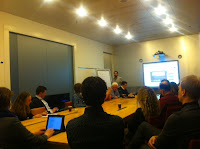.JPG) We started out the workshop with sharing who we are and how we cope with email. Surprisingly most says they cope with email quite well and don't experience email as a huge issue. But all would like to use email in a better way and get others to do so as well. All participants have some kind of collaboration tool inside their firewall (not saying it's used well or not).
We started out the workshop with sharing who we are and how we cope with email. Surprisingly most says they cope with email quite well and don't experience email as a huge issue. But all would like to use email in a better way and get others to do so as well. All participants have some kind of collaboration tool inside their firewall (not saying it's used well or not).Luis Suarez finds many high-level manager balk when they hear the word 'social', so he uses 'open' more. He stresses that email is a great way to share information. Which is true, says Luis. But you must add: in a silo. And his 'war' on email is not about killing email but repurposing it.
Luis asks why colleagues of the partipants are reluctant to use (internal) social/open tools:
- time
- no big value
- loss of control
- relevance of information
- convenience
- availability
- security
- resources
- governance
- no fame
- what's in it for me?
- over-sharing
- extra tool
- not business critical
- etc.
- thank you's
- cover you butt
- to do's
- attachment
- meetings
- reminders
- answers to questions
- notifications
- follow-up
- bacn (notifications from social networks)
What are the benefits of doing this in open/social platforms? We didn't have a lot of time to go into this. Luis advises us to define these benefits personally and show what how this helps us in our own work.
Luis wraps up his workshop with two tips that lead to 80% less email:
- apply the above-mentioned use cases
- stop responding to email today
.JPG)


